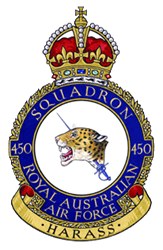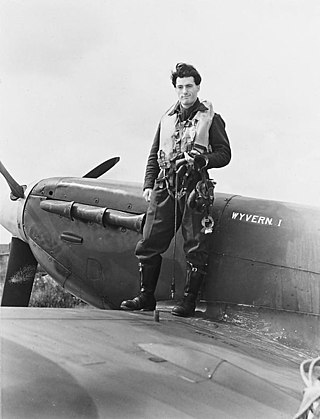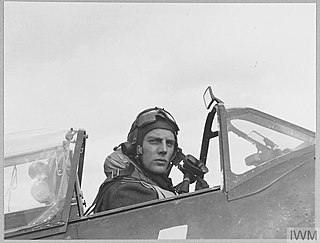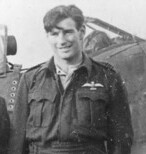
Air Vice-Marshal William Vernon Crawford-Compton, was a New Zealand flying ace of the Royal Air Force (RAF) during the Second World War. He was officially credited with destroying at least 20 German aircraft.

No. 452 Squadron is a Royal Australian Air Force (RAAF) air traffic control unit. It was established in 1941 as a fighter squadron, in accordance with Article XV of the Empire Air Training Scheme during World War II. The squadron flew Supermarine Spitfires for the entire war, initially over the United Kingdom and Nazi-occupied Europe. It was later based in Australia and the Netherlands East Indies, before being disbanded in 1945. It was re-raised in its current role in February 2011.

No. 450 Squadron was a unit of the Royal Australian Air Force (RAAF) that operated during World War II. Established at RAAF Station Williamtown, New South Wales, in February 1941, it was the first Australian Article XV squadron formed under the Empire Air Training Scheme.

Group Captain Colin Falkland Gray, was a Royal Air Force (RAF) officer and the top New Zealand fighter ace of the Second World War. He was credited with at least 27 aerial victories.

Raymond Brown Hesselyn, was a New Zealand fighter pilot and flying ace of the Second World War, credited with the destruction of at least 18 enemy aircraft while flying with the Royal Air Force (RAF) over Europe and the Mediterranean.

Harvey Nelson Sweetman, was a New Zealand fighter pilot of the Second World War. He flew extensively with No. 486 (NZ) Squadron over Europe and was later commander of No. 3 Squadron. He was credited with shooting down three aircraft and at least eleven V-1 flying bombs.

Reginald Joseph Cowan Grant, was a New Zealand flying ace of the Royal New Zealand Air Force (RNZAF) in the Second World War.

Gray Stenborg was a New Zealand flying ace of the Royal New Zealand Air Force (RNZAF) during the Second World War. He was credited with 14 confirmed victories, one shared destroyed, and three damaged.

Mervyn Robert Bruce Ingram, was a New Zealand flying ace of the Royal New Zealand Air Force (RNZAF) during the Second World War. He is credited with at least eight aerial victories.

John William Yarra was an Australian flying ace of the Royal Australian Air Force (RAAF) during the Second World War. He was credited with at least twelve aerial victories.

Basil Gordon Collyns, was a New Zealand flying ace of the Royal New Zealand Air Force (RNZAF) during the Second World War. He is credited with at least five aerial victories.

Harold Leslie North, was a New Zealand flying ace of the Royal Air Force (RAF) during the Second World War. He was officially credited with the destruction of at least five German aircraft although postwar research indicates some uncertainty regarding his tally.

Robert Wilton Bungey was an Australian fighter pilot of the Royal Air Force (RAF) and later the Royal Australian Air Force (RAAF) during the Second World War. Officially, he was credited with five aerial victories and thus qualified as a flying ace but there is some uncertainty regarding this.

Alan Francis Eckford was a British flying ace of the Royal Air Force (RAF) during the Second World War. He was credited with at least eight aerial victories.

Edward Francis John Charles, was an English-born Canadian officer and flying ace who served in the Royal Canadian Air Force (RCAF) and the Royal Air Force (RAF) during the Second World War. During his service with the RAF, he was credited with at least fifteen aerial victories.
John Davidson Mitchner, was a Canadian flying ace who served in the Royal Canadian Air Force (RCAF) during the Second World War. During his service with the RCAF, he was credited with at least ten aerial victories.

William Thomas Klersy, was a Canadian flying ace who served in the Royal Canadian Air Force (RCAF) during the Second World War. During his service with the RCAF, he was credited with at least fifteen aerial victories.
George Urquhart Hill, was a flying ace who served in the Royal Canadian Air Force (RCAF) during the Second World War. He was credited with having shot down at least eighteen aircraft.

Raymond Thorold-Smith, was an Australian flying ace who served in the Royal Australian Air Force (RAAF) during the Second World War. He was credited with having shot down at least six aircraft.
John Shepherd, was a British flying ace who served with the Royal Air Force (RAF) during the Second World War. He was credited with having shot down at least thirteen aircraft as well as seven V-1 flying bombs.


















